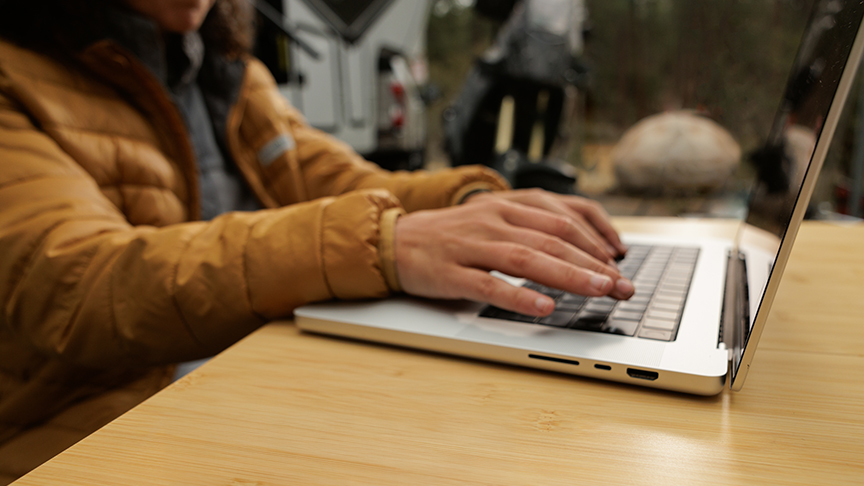
Public Wi-Fi networks may be quick and easy to connect to—and that's exactly why hackers love them.
Maybe you are bored during your two-hour layover, or you are trying to send emails at a coffee shop, or, perhaps, you can’t wait until you leave the restaurant before making your Instagram post. Public Wi-Fi networks are conveniently everywhere, but there are serious risks associated with them that are all but convenient. However tempted you may be to join that “free” Wi-Fi, remember that it may come at a great cost.
When you join a public Wi-Fi network, “your data is essentially broadcasting in the open,” says Jacob Kalvo, a cybersecurity expert and the co-founder and CEO at Live Proxies. Joining dangerous public Wi-Fi networks should be your last resort, and there are much safer options for those who bounce around from city to city. Because there are so many ways attackers may target you, it is important to understand even the little things you can do to protect yourself and your data.
- Jacob Kalvo, a tech and cybersecurity expert and founder & CEO of Live Proxies, contributed expertise to this article.
- This article was reviewed for accuracy by Jeff Gwinnell, a connectivity specialist at TravlFi.
Can You Get Hacked Using Public Wi-Fi?
Although they may seem harmless, public Wi-Fi networks can leave you vulnerable to hacking, and it happens more than you might think, according to Kalvo. Most commonly, connecting to public Wi-Fi in busy areas such as airports, coffee shops, and hotels increases your chances of getting hacked because just about anyone can connect—especially if the network is not password protected or has weak to no encryption standards.
According to Kalvo, it’s not too difficult either: “Any attacker with a basic packet-sniffing tool…can easily intercept your unprotected data,” he says. Packet-sniffing tools monitor the traffic—or packets of data—that travel across a network. This can include usernames and passwords, emails, or other sensitive information.
Risks of Using Public Wi-Fi
Kalvo points out three major approaches that cyberattackers may use in an attempt to steal your data. Understanding their approaches can help inform your decision on how to best stay protected.
Man-in-the-Middle Attacks
In some instances, attackers will place themselves between your device and the server you are trying to connect to; these are called man-in-the-middle (MITM) attacks. Once the attack is initiated, attackers may gain access to sensitive information or even alter the traffic (or data transfer) between device and server, according to Kalvo. Unfortunately, this means HTTPS-protected connections are also vulnerable to MITM attacks if the attacker reconfigures your browser to an unencrypted protocol.
“Evil Twin” Attacks
Kalvo also warns against “evil twin” attacks—or rogue hotspots established by attackers to imitate a legitimate network. Once connected, the attacker can observe your online activity or inject malware into your device. There is even the possibility of rogue servers, Kalvo adds, which may “[divert] your traffic to counterfeit websites that look legitimate but are designed to capture your login credentials or load ransomware” to your device.
Session Hijacking
Another serious threat when using public Wi-Fi is session hijacking. This occurs when an attacker can take over your active online session token, gaining full access to your account without a password, according to Kalvo. For example, when you log into your social media account or bank account, a session hijacker can obtain access to your accounts and potentially conduct financial transactions or steal sensitive information.
How to Stay Safe on Public Wi-Fi
Yes, the risks of using public Wi-Fi networks are scary, but luckily, there are precautions you can take to protect yourself and your information.
Use a VPN
Kalvo recommends a reputable VPN—or virtual private network—as a great way to stay safe while connected to public Wi-Fi. VPNs work by encrypting your network connection so that, as data travels between your device and the server, it remains hidden from others. It is best to avoid free VPNs because they may keep track of or sell your data, says Kalvo. Instead, he recommends OpenVPN or WireGuard which enforce strong protocols.
Look for HTTPS
To avoid sketchy or unprotected websites that may lead to data breaches, you can check that all websites you visit start with “https.” HTTPS encrypts website activity, and even though it does not completely mask your visit to a certain site, it hides any sensitive content you may enter on the site, Kalvo explains.
You can also check for the padlock in your search bar to ensure a website is secure. If you are nervous about accidentally visiting a website that is not HTTPS protected, you can install a browser extension, like HTTPS Everywhere, to only allow access to HTTPS protected sites, Kalvo advises.
Disable Automatic Wi-Fi Connection
To avoid unknowingly connecting to dangerous public networks, Kalvo recommends disabling automatic Wi-Fi connection. This way, your devices will only manually connect to networks with your permission and knowledge.
Avoid Accessing Sensitive Information
The simplest way to avoid giving attackers access to your important information is to simply avoid accessing such information on public Wi-Fi networks. Try to reserve banking activity or other sensitive browsing for private or trusted networks only in order to minimize the risks of unknown parties having access.
FAQs
What can others see when I use public Wi-Fi?
“What others can see when you are on public Wi-Fi depends on the network configuration and how protected you are,” according to Jacob Kalvo, a cybersecurity expert and the co-founder and CEO at Live Proxies.
While on a public Wi-Fi network—especially one that is not encrypted—other users of the network and the network owner can observe what websites you visit by intercepting network traffic at the domain level.
This does not mean, however, that other users can access specific content on the websites as HTTPS encrypts such information. Kalvo also points out that some Wi-Fi networks may have monitoring software installed, which records what devices are connected and makes it easier to connect online activity to your specific device.
Is public Wi-Fi the same as unsecured Wi-Fi?
Public Wi-Fi and unsecured Wi-Fi are not necessarily equivalent. A public Wi-Fi network simply means that anyone in a specific area is able to connect; public Wi-Fi networks generally require a password to join, but they may or may not be encrypted.
Unsecured Wi-Fi networks, however, indicate that no security measures exist for the network. These are more dangerous than public Wi-Fi networks because anyone can access the network freely and potentially snoop on your activity, according to Jacob Kalvo, a cybersecurity expert and the co-founder and CEO at Live Proxies.
How dangerous is it actually to use public Wi-Fi?
Using public Wi-Fi comes with some serious risks. Hacking, data theft, and malware injection can occur on public Wi-Fi networks through a variety of attacker methods. Some attackers may set up fake hotspots that, once joined, can give them access to monitor your actions or inject malware to your device. Other threats include session hijacking—when an attacker takes over your active session data interception with packet-sniffing tools (software or hardware that monitors traffic across a network), according to Jacob Kalvo, a cybersecurity expert and the co-founder and CEO at Live Proxies.
Is it safe to use unsecured Wi-Fi in hotels?
You are never risk-free when using unsecured Wi-Fi networks. Because these networks are unencrypted, they are “essentially open invitations for hackers to siphon your traffic,” according to Jacob Kalvo, a cybersecurity expert and the co-founder and CEO at Live Proxies.
This means whether you are at a hotel, coffee shop, airport, or anywhere in between, anyone with a basic packet-sniffing tool (software or hardware that monitors traffic across a network) could easily obtain passwords and other sensitive information. Additionally, joining unsecured networks makes you more susceptible to being infected with malware. If you have no choice but to connect to an unsecured network, Kalvo recommends using a VPN to encrypt your traffic for a layer of security.
Is public Wi-Fi safe if I use a VPN?
Public Wi-Fi becomes much safer if you use a reputable VPN. Because a VPN “encrypts your entire internet connection from your device to the VPN server,” it hides your activity, making it harder for attackers to access your data, says Jacob Kalvo, a cybersecurity expert and the co-founder and CEO at Live Proxies. You should look for VPNs with strong protocols—Kalvo suggests OpenVPN or WireGurad—while avoiding free VPNs that may sell your data.
Jeff Gwinnell, connectivity specialist at TravlFi, says, “There are numerous types of VPN services and providers on the market with varying levels of security and reputation. VPNs can be as simple as an application running in the background to being based within hardware such a router. Do your homework and pick the most reputable and secured provider. Lastly, keep in mind that not all VPN services and protocols are ‘universally’ supported. There are some instances where a router doesn't support a VPN provider or an internet-based service may not work well over a VPN connection.”
Did You Like This Post? Read More Like It:
- Is RV Wi-Fi Any Good? RV-ing Experts Dish Out the Truth
- Ditch Your Phone Hotspot: The Real Difference Between a Mobile Hotspot vs Phone Hotspot for Traveling
- An RV Internet Expert Shares Tips for Optimal RV WiFi Setup
- TravlFi vs. Starlink: A Full-Time Vanlifer Compares Cost, Speeds, and Coverage
Don’t let cybercriminals get in the way of your travel journey. Learn More about TravlFi’s secure Wi-Fi solutions so you can have one less thing to worry about.

Article By: Ever Vigee
Ever Vigee is an award-winning writer and digital advertising student at Louisiana State University. A member of the LSU chapters of The National Association of Black Journalists and the American Advertising Federation, she grew up surrounded by creativity and enjoys expressing her ideas through graphic design, writing, photography, fashion, and music. Ever strives to be an effective communicator and is eager to travel and explore the world in ways that will supplement her creativity and understanding of different cultures.
